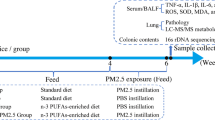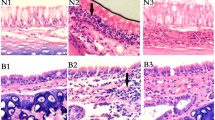Abstract
Air pollution of particulate matter (PM), especially PM2.5, has become a major public health problem in China. Exploration of therapeutic and preventive measures against PM2.5 toxicity is of practical significance. The aim of this study was to examine the inhibitory effects of chitosan oligosaccharides (COS) on PM2.5-induced lung inflammation in rats. Forty SPF (specific pathogen-free) male Wistar rats weighing 200–220 g were randomly divided into four groups: control group, COS group, PM2.5 group, and PM2.5+COS group. COS was pre-administered to rats by gavage at a single dose of 500 mg/kg 2 h before intratracheal instillation of PM2.5 at a single dose of 1.2 mg/kg daily for 3 consecutive days. Normal saline (NS) was used as negative control. Twenty-four hours after the last instillation of PM2.5, rats were sacrificed and subjected to bronchoalveolar lavage (BAL). The BAL fluids (BALF) were collected for measurement of levels of total proteins, lactate dehydrogenase (LDH), interleukin-1 (IL-1β), IL-8, and tumor necrosis factor-ɑ (TNF-ɑ) using colorimetric or ELISA kits. Levels of total proteins, LDH activities, and pro-inflammatory mediators including IL-1β, IL-8, and TNF-ɑ in BALF of rats in PM2.5 group significantly increased in comparison with those of the control group. Pre-treatment of rats with COS markedly blocked PM2.5-induced increase in LDH, IL-8, and TNF-ɑ levels in BALF. In conclusion, PM2.5 exposure induces rat lung inflammation, which could be ameliorated by the pre-treatment of COS.


Similar content being viewed by others
Abbreviations
- PM:
-
particulate matter
- NS:
-
normal saline
- BALF:
-
bronchoalveolar lavage fluids
- LDH:
-
lactate dehydrogenase
- IL:
-
interleukin
- COS:
-
chitosan oligosaccharides
- LD50:
-
the median lethal dose
- TNF-ɑ:
-
tumor necrosis factor-ɑ
- ROS:
-
reactive oxygen species
- iNOS:
-
inducible nitric oxide synthase
- GSH:
-
glutathione
- SOD:
-
superoxide dismutase
- NF-κB:
-
nuclear transcription factor κB
References
Abrahamowicz M, Schopflocher T, Leffondré K, du Berger R, Krewski D (2003) Flexible modeling of exposure-response relationship between long-term average levels of particulate air pollution and mortality in the American Cancer Society study. J Toxicol Environ Health A 66(16–19):1625–1654
Anandan R, Ganesan B, Obulesu T, Mathew S, Kumar RS, Lakshmanan PT, Zynudheen AA (2012) Dietary chitosan supplementation attenuates isoprenaline-induced oxidative stress in rat myocardium. Int J Biol Macromol 51(5):783–787
Bueter CL, Lee CK, Wang JP, Ostroff GR, Specht CA, Levitz SM (2014) Spectrum and mechanisms of inflammasome activation by chitosan. J Immunol 192(12):5943–5951
Canali MM, Pedrotti LP, Balsinde J, Ibarra C, Correa SG (2012) Chitosan enhances transcellular permeability in human and rat intestine epithelium. Eur J Pharm Biopharm 80(2):418–425
Chen F, Castranova V, Shi X, Demers LM (1999) New insights into the role of nuclear factor-kappaB, a ubiquitous transcription factor in the initiation of diseases. Clin Chem 45(1):7–17
Cho YS, Kim SK, Je JY (2011) Chitosan gallate as potential antioxidant biomaterial. Bioorg Med Chem Lett 21:3070–3073
De Prins S, Dons E, Van Poppel M, Int Panis L, Van de Mieroop E, Nelen V, Cox B, Nawrot TS, Teughels C, Schoeters G, Koppen G (2014) Airway oxidative stress and inflammation markers in exhaled breath from children are linked with exposure to black carbon. Environ Int 73:440–446
Fang IM, Yang CH, Yang CM, Chen MS (2013) Chitosan oligosaccharides attenuates oxidative-stress related retinal degeneration in rats. PLoS One 8(10):e77323
Gold DR, Litonjua A, Schwartz J, Lovett E, Larson A, Nearing B, Allen G, Verrier M, Cherry R, Verrier R (2000) Ambient pollution and heart rate variability. Circulation 101(11):1267–1273
Ibald-Mulli A, Stieber J, Wichmann HE, Koenig W, Peters A (2001) Effects of air pollution on blood pressure: a population-based approach. Am J Public Health 91(4):571–577
Izzotti A, Parodi S, Quaglia A, Farè C, Vercelli M (2000) The relationship between urban airborne pollution and short-term mortality: quantitative and qualitative aspects. Eur J Epidemiol 16(11):1027–1034
Jin Y, Wu W, Zhang W, Zhao Y, Wu Y, Ge G, Ba Y, Guo Q, Gao T, Chi X, Hao H, Wang J, Feng F (2017) Involvement of EGF receptor signaling and NLRP12 inflammasome in fine particulate matter-induced lung inflammation in mice. Environ Toxicol 32(4):1121–1134
Kumar MN, Muzzarelli RA, Muzzarelli C, Sashiwa H, Domb AJ (2004) Chitosan chemistry and pharmaceutical perspectives. Chem Rev 104:6017–6084
Li N, Xia T, Nel AE (2008) The role of oxidative stress in ambient particulate matter-induced lung diseases and its implications in the toxicity of engineered nanoparticles. Free Radic Biol Med 44(9):1689–1699
Liu HT, Li WM, Xu G, Li XY, Bai XF, Wei P, Yu C, Du YG (2009) Chitosan oligosaccharides attenuate hydrogen peroxide-induced stress injury in human umbilical vein endothelial cells. Pharmacol Res 59:167–175
Lu K, Qin Y, He GX, Gao GF (2013) The impact of haze weather on health: a view to future. Biomed Environ Sci 26(12):945–946
Mendis E, Kim MM, Rajapakse N, Kim SK (2007) An in vitro cellular analysis of the radical scavenging efficacy of chitooligosaccharides. Life Sci 80(23):2118–2127
Pae HO, Seo WG, Kim NY, Oh GS, Kim GE, Kim YH, Kwak HJ, Yun YG, Jun CD, Chung HT (2001) Induction of granulocytic differentiation in acute promyelocytic leukemia cells (HL-60) by water-soluble chitosan oligomer. Leuk Res 25(4):339–346
Patti AM, Katsiki N, Nikolic D, Al-Rasadi K, Rizzo M (2015) Nutraceuticals in lipid-lowering treatment: a narrative review on the role of chitosan. Angiology 66(5):416–421
Peng H, Zhao XH, Bi TT, Yuan XY, Guo JB, Peng SQ (2017) PM2.5 obtained from urban areas in Beijing induces apoptosis by activating nuclear factor-kappaB. Mil Med Res 4(1):27
Pope CA 3rd, Verrier RL, Lovett EG, Larson AC, Raizenne ME, Kanner RE, Schwartz J, Villegas GM, Gold DR, Dockery DW (1999) Heart rate variability associated with particulate air pollution. Am Heart J 138(5 Pt 1):890–899
Rodríguez-Cotto RI, Ortiz-Martínez MG, Rivera-Ramírez E, Mateus VL, BS3 A, Jiménez-Vélez BD, Gioda A (2014) Particle pollution in Rio de Janeiro, Brazil: increase and decrease of pro-inflammatory cytokines IL-6 and IL-8 in human lung cells. Environ Pollut 194:112–120
Rodríguez-Cotto RI, Ortiz-Martínez MG, Rivera-Ramírez E, Méndez LB, Dávila JC, Jiménez-Vélez BD (2013) African dust storms reaching Puerto Rican coast stimulate the secretion of IL-6 and IL-8 and cause cytotoxicity to human bronchial epithelial cells (BEAS-2B). Health (Irvine Calif) 5(10B):14–28
Routledge HC, Ayres JG, Townend JN (2003) Why cardiologists should be interested in air pollution. Heart 89(12):1383–1388
Villiers C, Chevallet M, Diemer H, Couderc R, Freitas H, Van Dorsselaer A, Marche PN, Rabilloud T (2009) From secretome analysis to immunology chitosan induces major alterations in the activation of dendritic cells via a TLR-4 dependent mechanism. Mol Cell Proteomics 8(6):1252–1264
Wallenborn JG, McGee JK, Schladweiler MC, Ledbetter AD, Kodavanti UP (2007) Systemic translocation of particulate matter-associated metals following a single intratracheal instillation in rats. Toxicol Sci 98(1):231–239
Wu JN, Zhang P, Yi HT, Qin Z (2016) What causes haze pollution? An empirical study of PM2.5 concentrations in Chinese cities. Sustainability 8(2):132
Xing YF, Xu YH, Shi MH, Lian YX (2016) The impact of PM2.5 on the human respiratory system. J Thorac Dis 8(1):E69–E74
Xiong QY, Wei YN, Xie HD, Feng ZX, Gan Y, Wang CL, Liu MJ, Bai FF, Xie F, Shao GQ (2014) Effect of different adjuvant formulations on the immunogenicity and protective effect of a live mycoplasma hyopneumoniae vaccine after intramuscular inoculation. Vaccine 32(27):3445–3451
Yan Z, Wang J, Li J, Jiang N, Zhang R, Yang W, Yao W, Wu W (2016) Oxidative stress and endocytosis are involved in upregulation of interleukin-8 expression in airway cells exposed to pm2.5. Environ Toxicol 31(12):1869–1878
Yoon HJ, Moon ME, Park HS, Kim HW, Im SY, Lee JH, Kim YH (2008) Effects of chitosan oligosaccharide on the glycerol-induced acute retinal failure in vitro and vivo. Food Chem Toxicol 46:710–706
Zhang Q, Crooks R (2013) Toward an environmentally sustainable future: country environmental analysis of the People’s Republic of China. Report Asian Development Bank 01:55–56
Zhang XY, Wang YQ, Niu T (2012) Atmospheric aerosol compositions in China: spatial/temporal variability, chemical signature, regional haze distribution and comparisons with global aerosols. Atmos Chem Phys 12:779–799
Zhao YZ, Xu G, WU H, Han G, Zhang H (2013) Protective effects of chitosan on cadmium-induced oxidative damage in liver mitochondria of rats. J Environ Health 30(10):884–886
Funding
This study was funded by the National Natural Science Foundation of China (81573112; 81373030; 81370916), the Henan International Collaborative Laboratory for Air Pollution Health Effects and Intervention, and the Basic and Frontier Technology Research Grant of Henan Province (144300510055).
Author information
Authors and Affiliations
Contributions
Weidong Wu designed the study and revised the manuscript. Yingzheng Zhao and Guangcui Xu conducted the experiments. Shouying Wang drafted the manuscript and analyzed the data. Xianwen Yi participated in the design of this project and revised the manuscript. All listed authors have read and approved the final manuscript.
Corresponding author
Ethics declarations
Animal use and care procedures were approved by the Institutional Animal Care and Use Committee of the Xinxiang Medical University strictly in accordance with the Guidelines of Xinxiang Medical University for Animal Experiments.
Conflict of interest
The authors declare that they have no conflict of interest.
Additional information
Responsible editor: Philippe Garrigues
Rights and permissions
About this article
Cite this article
Zhao, Y., Xu, G., Wang, S. et al. Chitosan oligosaccharides alleviate PM2.5-induced lung inflammation in rats. Environ Sci Pollut Res 25, 34221–34227 (2018). https://doi.org/10.1007/s11356-018-3365-4
Received:
Accepted:
Published:
Issue Date:
DOI: https://doi.org/10.1007/s11356-018-3365-4




